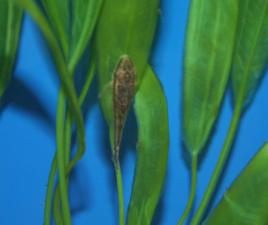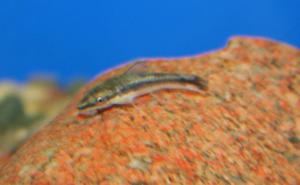
Upside-Down Catfish (Synodontis nigriventris)
Overview: The Upside Down Cat is also known as the Blotched Upside Down Catfish and is from the rivers and lakes of Central Africa within the Congo Basin. It is one of the smaller Synodontis catfish, and is an opaque color with many black spots and markings. This species is an upside-down catfish, as it will hang in an inverted position, as well as feed from the surface of the water.
Native Range: Central Africa
Max. Length: 4 inches
Water: 75-82° F, KH 4-12, pH 6.0-7.5
Feeding: Omnivore
Behavior & Care: The Upside Down Cat will appreciate a heavily planted aquarium of 30 gallons or more, with driftwood and crevices for hiding. Sensitive to nitrates, good water conditions are necessary.
|
|

Jaguar Catfish (Liosomadoras oncinus)
Overview: The Jaguar catfish is named after the intangible Jaguar, and just like its feline namesake, the Jaguar catfish can only be found on the South American continent. Aquarists began to interested themselves in this beautiful species when it started to arrive as a contaminant in shipments from South America.
Native Range: South America
Max. Length: 8 inches
Water: 70-78ºF; pH 5.8-6.5
Feeding: Omnivore
Behavior & Care: Unlike many other popular catfish species, the Jaguar catfish does not form schools. It is a highly territorial species and this must be taken into consideration when you set up your aquarium. It is possible to house several Jaguar catfishes in the same aquarium if it is large enough, but this calls for a clever aquarium decoration that break up the aquarium into several different territories. There must also be plenty of hiding spots throughout the aquarium. Include driftwood and pieces of PVC pipes or similar.
|
|

Panda Cory Cat (Corydoras panda)
Overview: The Panda Cory Cat comes from the tributaries of larger river systems in Central & South America, and is a peaceful bottom dwelling scavenger. The Panda is gold with black patches covering the eyes, dorsal fin, and at the base of the tail.
Native Range: Asia, Tank Bred
Max. Length: 2.5 inches
Water: 72-79° F, KH 2-12, pH 5.8-7.0
Feeding: Omnivore
Behavior & Care: The Panda Cory Cat requires a well planted aquarium with plenty of hiding places that provide relief from the light. A smooth sand or gravel substrate is needed because of the easily damaged barbels. They enjoy being in numbers, so a small school of six or more is ideal for these cats.
|
|
 
Otocinclus Catfish (Otocinclus vestitus)
Overview: The Otocinclus Catfish is the algae-busting favorite of aquarium hobbyists. Even award-winning planted-aquarium experts like Takashi Amano will employ this tireless algae eater. The diminutive Otocinclus Catfish does a great job keeping aquarium glass and plants free of distracting green.
Native Range: South America
Max. Length: 2 inches
Water: 74-79° F, KH 6-10, pH 6.8-7.5
Feeding: Herbivore
Behavior & Care: The Otocinclus is one of the smallest catfish in the Loricariidae family. Featuring a tan with a black peppered body, the Otocinclus Catfish is an attractive and functional addition to any freshwater aquarium. Originating from fast-moving rivers in South America, the Otocinclus Catfish should be housed in at least a 10-gallon aquarium with high filtration, good water movement, and high aeration.
|
|

Synodontis Eupterus Catfish (Synodontis Eupterus)
Overview: The synodontis eupterus belongs to the family of Mochokidae and shares its place among approximately 170 species, 50 of which belong to the same group of Synodontis.
Native Range: Africa
Max. Length: 8 inches
Water: 72-79°F, pH: 6.5-7.8
Feeding: Omnivore
Behavior & Care: As a catfish, it is quite hardy and can be forgiving and accommodating to a variety of water conditions and tank mates, making it an ideal beginner's fish. It is relatively peaceful in temperament, and despite its omnivorous nature, hardly ever bothers other bottom dwellers even if they are very small in size, but can be picky with its tank mates, harassing the unlucky one that it dislikes.
|
|

Albino Aeneus Corydora (Aeneus Corydoras)
Overview: The Albino Aeneus Cory Cat comes from the tributaries of the Amazon river and is a peaceful bottom dwelling scavenger. The Albino variety is mostly white to pink, and has multiple barbels around the mouth.
Native Range: Farm Raised - USA, Indonesia, Singapore
Max. Length: 3 inches
Water: 72-79° F, KH 2-12, pH 5.8-7.0
Feeding: Omnivore
Behavior & Care: The Aeneus Cory Cat requires a well planted aquarium with plenty of hiding places that provide relief from the light. A smooth sand or gravel substrate is needed because of the easily damaged barbels. They enjoy being in numbers, so a small school of six or more is ideal for these cats.
|
|

Julii Cory (Corydoras Julii)
Overview: Corydoras julii, also known as the Julii Cory or Leopard Catfish, is a member of the Corydoras family. Corys are small, bottom dwelling scavenger catfish that are loved by aquarium keepers for their looks, personalities, and bottom cleaning skills.
Native Range: Native to parts of the lower Amazon and a few coastal rivers in northeastern Brazil.
Max. Length: 2.5 inches
Water: 73 to 79°F, pH: 6.0 to 7.2
Feeding: Omnivore
Behavior & Care: Very peaceful aquarium residents. Although they'll consume bite-sized items such as eggs or fry, aggression towards other species is virtually unheard of. Intraspecific hostility is similarly unusual, occurring in only a handful of species.
|
|

Pictus Catfish (Pimelodus pictus)
Overview: The Pictus Cat is a member of the antenna catfish group and usually has a pale to gray body with a black spotted pattern. The pectoral fins are serrated, so it is recommended that a glass bowl or cup be used to capture the fish rather than a net.
Native Range: South America
Max. Length: 5 inches
Water: 75-81° F, pH 7.0-7.5
Feeding: Omnivore
Behavior & Care: the Pictus Cat can be housed with any soft water tank mate. Care should be taken when adding small fish to the aquarium as they may become prey to the Pictus Cat if they are able to fit them in their mouth. Tanks with dim light that are heavily planted are ideal for this fish. Rocks, caves, and driftwood also aid in providing an optimal environment for the Pictus Cat. In the wild, this fish grows a bit larger than in the aquarium setting, but a minimum of 70 gallons is recommended for proper housing.
|
|

Twig Catfish (Farowella vittata)
Overview: Farlowella has a unique body shape that resembles of a thin stick of wood. The body is slender and elongated, often with a pronounced rostrum and a brownish color with two lateral dark stripes beginning at the tip of the rostrum, passing over the eyes and ending at the tail, which are periodically interrupted on the caudal peduncle.
Max. Length: 7 inches
Water: 75-80°F, pH: 6.0-7.0
Feeding: Algae Eater
Behavior & Care: Very peaceful but unsuitable for the general community due to its rather specialized requirements and retiring nature. Not only does it require pristine water, but it will easily be outcompeted for food by more vigorous or larger species. Possible tankmates could include small characins, danios, devarios and other Loricariids inhabiting similar waters, such as Chaetostoma.
|
|

Aeneus Cory Cat (Aeneus Corydoras)
Overview: The Aeneus Cory Cat comes from the tributaries of the Amazon river and is a peaceful bottom dwelling scavenger.
Native Range: Farm Raised - USA, Indonesia, Singapore
Max. Length: 2 inches
Water: 72-79° F, KH 2-12, pH 5.8-7.0
Feeding: Omnivore
Behavior & Care: The Aeneus Cory Cat requires a well planted aquarium with plenty of hiding places that provide relief from the light. A smooth sand or gravel substrate is needed because of the easily damaged barbels. They enjoy being in numbers, so a small school of six or more is ideal for these cats.
|
|
| |












